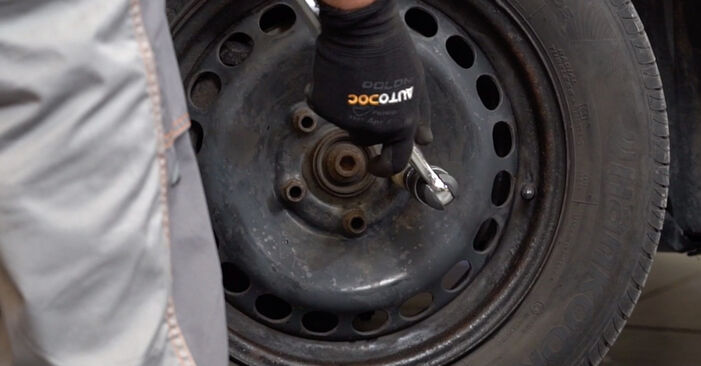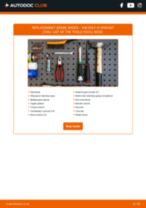
Disclaimer
How to change rear brake shoes on VW Golf 3 – replacement guide
downloads:
25
Views:
302
Recommended replacement interval for the part category Brake Shoe Set : 100000 km
Important!
This replacement procedure can be used for:
VW GOLF III (1H1) 1.4, VW GOLF III (1H1) 1.9 D, VW GOLF III (1H1) 1.9 TD, GTD, VW GOLF III (1H1) 1.9 TDI, VW GOLF III (1H1) 1.6, VW GOLF III (1H1) 1.8, VW GOLF III (1H1) 1.8, VW GOLF III (1H1) 1.8 Syncro (1HX1), VW GOLF III (1H1) 1.6, VW GOLF III (1H1) 1.9 SDI … View more
The steps may slightly vary depending on the car design.
VW GOLF III (1H1) 1.4, VW GOLF III (1H1) 1.9 D, VW GOLF III (1H1) 1.9 TD, GTD, VW GOLF III (1H1) 1.9 TDI, VW GOLF III (1H1) 1.6, VW GOLF III (1H1) 1.8, VW GOLF III (1H1) 1.8, VW GOLF III (1H1) 1.8 Syncro (1HX1), VW GOLF III (1H1) 1.6, VW GOLF III (1H1) 1.9 SDI … View more
The steps may slightly vary depending on the car design.
How to change brake shoes on VW GOLF 3 [TUTORIAL AUTODOC]

All the parts you need to replace – Brake Shoes for GOLF III (1H1) and other VW models
Alternative products

Wire brush
WD-40 spray
Copper grease
Combination spanner #24
Wheel impact socket #17
Ratchet wrench
Torque wrench
Pliers
Flat chisel
Hammer
Rubber mallet
Flat Screwdriver
Nippers
Wheel chock
Replacement: brake shoes – VW Golf 3. AUTODOC experts recommend:
- Perform the replacement of brake pads in complete set for each axis. This provides effective braking.
- The replacement procedure is identical for all brake pads on the same axle.
- All work should be done with the engine stopped.
Replacement: brake shoes – VW Golf 3. Take the following steps:
- Step 1
 Open the bonnet. Unscrew the brake fluid reservoir cap.
Open the bonnet. Unscrew the brake fluid reservoir cap. - Step 2
 Secure the wheels with chocks.
Secure the wheels with chocks. - Step 3
 Loosen the wheel mounting bolts. Use wheel impact socket #17.
Loosen the wheel mounting bolts. Use wheel impact socket #17. - Step 4
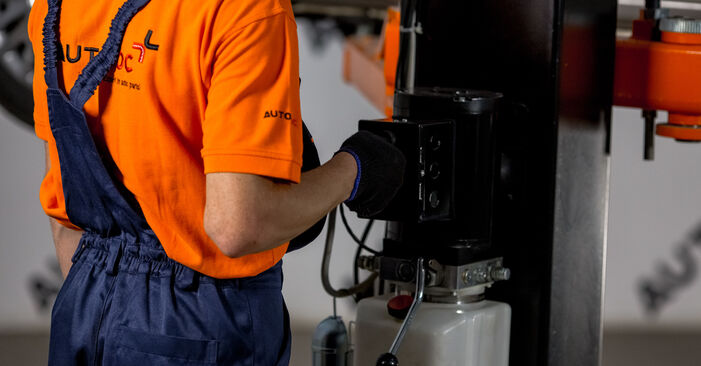 Raise the rear of the car and secure on supports.
Raise the rear of the car and secure on supports. - Step 5
 Unscrew the wheel bolts.AUTODOC recommends:Warning! To avoid injury, hold the wheel while unscrewing the fastening bolts. VW Golf 3
Unscrew the wheel bolts.AUTODOC recommends:Warning! To avoid injury, hold the wheel while unscrewing the fastening bolts. VW Golf 3 - Step 6
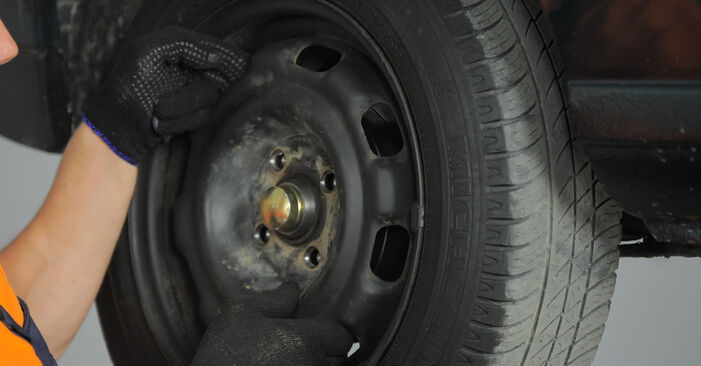 Remove the wheel.
Remove the wheel. - Step 7
 Remove the hub bearing protection cap. Use a flat metal-working chisel. Use a hammer. Use a flat screwdriver.Please note!Some cars are not equipped with wheel hub caps.
Remove the hub bearing protection cap. Use a flat metal-working chisel. Use a hammer. Use a flat screwdriver.Please note!Some cars are not equipped with wheel hub caps. - Step 8
 Remove the cotter pin securing the hub nut. Use nippers.
Remove the cotter pin securing the hub nut. Use nippers. - Step 9
 Unscrew the wheel hub axle nut. Use a combination spanner #24.
Unscrew the wheel hub axle nut. Use a combination spanner #24. - Step 10
 Remove the brake drum.Replacement: brake shoes – VW Golf 3. Tip:Examine the brake drum. Replace it if necessary.
Remove the brake drum.Replacement: brake shoes – VW Golf 3. Tip:Examine the brake drum. Replace it if necessary. - Step 11
 Remove the retaining spring of the brake pads. Use pliers.
Remove the retaining spring of the brake pads. Use pliers. - Step 12
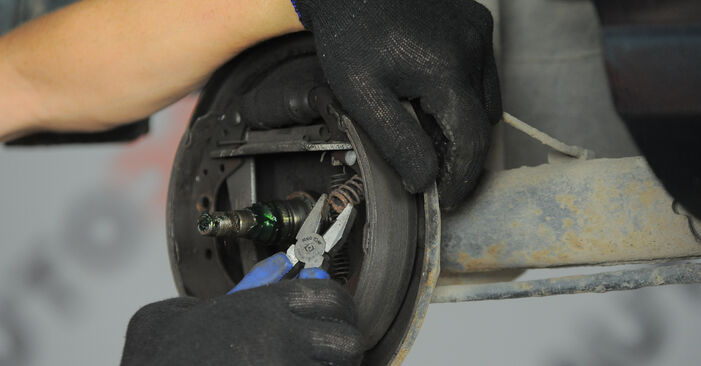 Remove the brake pads retaining clips. Use pliers.
Remove the brake pads retaining clips. Use pliers. - Step 13
 Pull both brake shoes with the adjuster from the working brake cylinder, avoiding damage to the boots.Replacement: brake shoes – VW Golf 3. Tip from AUTODOC experts:Don't press the brake pedal after removing the rear brake drum shoes. This will cause the piston to fall out of the brake cylinder, leakage of brake fluid and depressurization of the system.
Pull both brake shoes with the adjuster from the working brake cylinder, avoiding damage to the boots.Replacement: brake shoes – VW Golf 3. Tip from AUTODOC experts:Don't press the brake pedal after removing the rear brake drum shoes. This will cause the piston to fall out of the brake cylinder, leakage of brake fluid and depressurization of the system. - Step 14
 Disconnect the parking brake cable. Use nippers.
Disconnect the parking brake cable. Use nippers. - Step 15
 Remove the retaining spring of the brake pads.
Remove the retaining spring of the brake pads. - Step 16
 Remove both shoes from the mounting bracket.
Remove both shoes from the mounting bracket. - Step 17
 Perform further demounting of the upper retaining spring and the adjuster mechanism. Use pliers.
Perform further demounting of the upper retaining spring and the adjuster mechanism. Use pliers. - Step 18
 Install the upper retaining springs and adjustment mechanism on new brake shoes. Use pliers.
Install the upper retaining springs and adjustment mechanism on new brake shoes. Use pliers. - Step 19
 Place the brake shoes so that their inward edges rest on the anchor plate.
Place the brake shoes so that their inward edges rest on the anchor plate. - Step 20
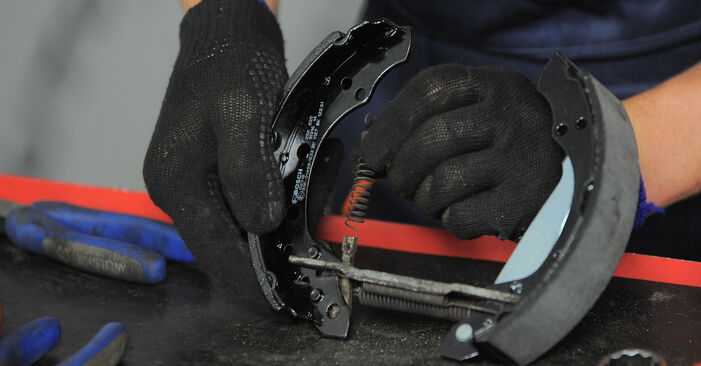 Install the retaining spring of the brake pads.
Install the retaining spring of the brake pads.
Was this manual helpful?
Please rate this manual on a scale from 1 to 5. If you have any questions, feel free to ask us.
Users voted – 0
Need New Tyres?
Find out which tyre and wheel sizes are compatible with the VW Golf III Hatchback (1H1) model

Popular maintenance tutorials for Golf 3
Complete guides for changing the Brake shoe set on different VW GOLF models
Unlock your car maintenance assistant!
Track expenses, manage logs, schedule replacements, and more.
Tips & tricks for your VW GOLF III (1H1)
View more
 K2 ROTON wheel cleaner overview
K2 ROTON wheel cleaner overview Why Checking Your Oil is Crucial for Engine Performance
Why Checking Your Oil is Crucial for Engine Performance Save Money on Fuel with These Easy Tips | AUTODOC
Save Money on Fuel with These Easy Tips | AUTODOC DIY rear axle restoration | Drivetrain restoration – Part 2
DIY rear axle restoration | Drivetrain restoration – Part 2
Most commonly replaced car parts on VW GOLF

Time to replace parts? Get even better deals in our Shop app.

SCAN ME

























